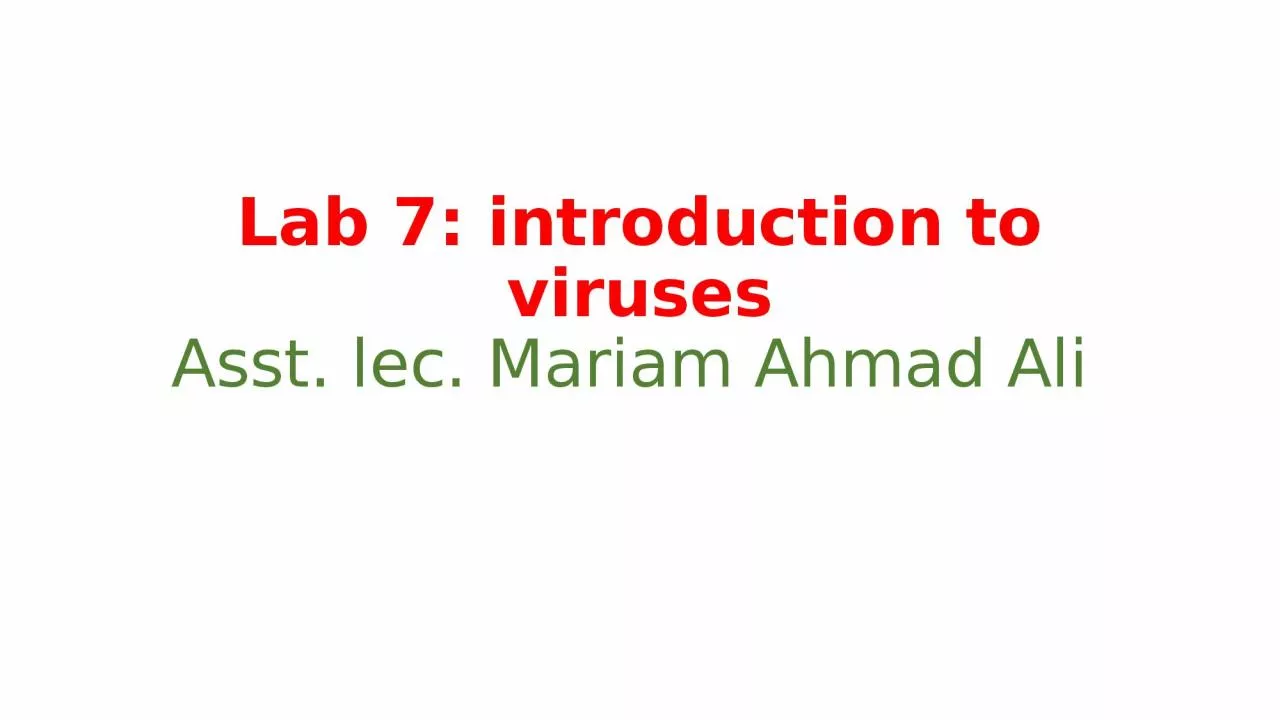

Asst lec Mariam Ahmad Ali Introduction to Viruses Viruses are the smallest infectious agents 20 300 nm in diameter containing only one kind of nucleic acid RNA or DNA as their genome The nucleic acid is encased in a protein shell which may be surrounded by a lipid ID: 1041470
Download Presentation The PPT/PDF document "Lab 7: introduction to viruses" is the property of its rightful owner. Permission is granted to download and print the materials on this web site for personal, non-commercial use only, and to display it on your personal computer provided you do not modify the materials and that you retain all copyright notices contained in the materials. By downloading content from our website, you accept the terms of this agreement.
1. Lab 7: introduction to virusesAsst. lec. Mariam Ahmad Ali
2. Introduction to VirusesViruses are the smallest infectious agents (20 -300 nm in diameter), containing only one kind of nucleic acid (RNA or DNA) as their genome. The nucleic acid is encased in a protein shell, which may be surrounded by a lipid – containing membrane. The entire infectious unit is termed a virion. Viruses are inert in the extra-cellular environment. They replicate only in living cells, being parasites at the genetic level.
3.
4. The structure of viruses:1. Viral nucleic acid:The viral nucleic acid is located internally and can be either single- or double- stranded RNA orDNA. The nucleic acid can be either linear or circular. The DNA is always a single molecule,the RNA can exist either as a single molecule or in several pieces (segmented). Some RNA viruses are positive polarity and others are negative polarity. Positive polarity is defined as an RNA with same base sequence as the mRNA. Negative polarity has a base sequence that is complementary to the mRNA.2. Capsid:The protein shell, or coat, that encloses the nucleic acid genome and mediates theattachment of the virus to specific receptors on the host cell surface.3. Capsomeres:Morphologic units seen in electron microscope. Each capsomere, consisting ofone or several proteins.Naked viruses are composed of nucleic acid + capsid (nucleocapsid)
5.
6. 4. Viral envelope :The envelope is a lipoprotein membrane composed of lipid derived from the host cellmembrane and protein that is virus- specific.Furthermore, there are frequently glycoproteins in form of spike-like projectionson the surface, which attach to host cell receptors.Matrix protein mediates the interaction between the capsid proteins and envelope.The presence of an envelope confers instability on the virus.Enveloped viruses NA + capsid + envelopeThe whole virus particle is called virion.Types
7.
8. Types of symmetry of virus particles:1. Icosahedral symmetryComposed of 12 vertices, has 20 faces (each an equilateral triangle) withthe approximate outline of a sphere.e.g. Herpesviruses , Adenoviruses
9. 2. Helical symmetryIn which the capsomeres are arranged in a hollow coil that appearsrod- shaped. The helix can be either rigid or flexible.e.g. Influenza viruses3. Complex structurese.g. Poxviruses
10. Growth cycle of virusesTake place in 7 stages as following:(Attachment ,pentration ,and uncaoting Transcrption, synthesis of viral components, Assembly, Release)